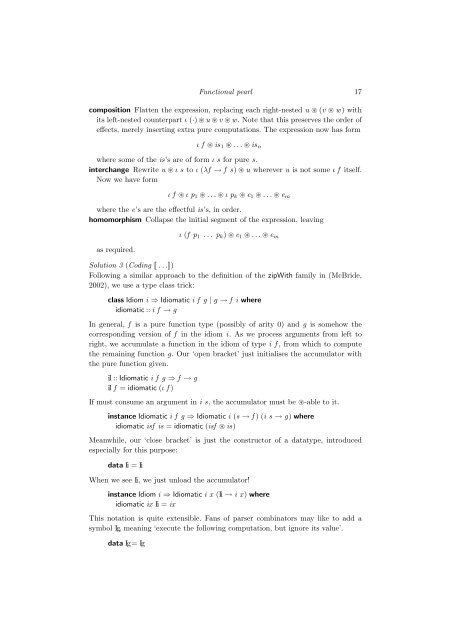Idiom
Idiom
Idiom
You also want an ePaper? Increase the reach of your titles
YUMPU automatically turns print PDFs into web optimized ePapers that Google loves.
Functional pearl 17<br />
composition Flatten the expression, replacing each right-nested u ⊛ (v ⊛ w) with<br />
its left-nested counterpart ι (·) ⊛ u ⊛ v ⊛ w. Note that this preserves the order of<br />
effects, merely inserting extra pure computations. The expression now has form<br />
ι f ⊛ is1 ⊛ . . . ⊛ isn<br />
where some of the is’s are of form ι s for pure s.<br />
interchange Rewrite u ⊛ ι s to ι (λf → f s) ⊛ u wherever u is not some ι f itself.<br />
Now we have form<br />
ι f ⊛ ι p1 ⊛ . . . ⊛ ι pk ⊛ e1 ⊛ . . . ⊛ em<br />
where the e’s are the effectful is’s, in order.<br />
homomorphism Collapse the initial segment of the expression, leaving<br />
as required.<br />
ι (f p1 . . . pk) ⊛ e1 ⊛ . . . ⊛ em<br />
Solution 3 (Coding . . .)<br />
Following a similar approach to the definition of the zipWith family in (McBride,<br />
2002), we use a type class trick:<br />
class <strong>Idiom</strong> i ⇒ <strong>Idiom</strong>atic i f g | g → f i where<br />
idiomatic :: i f → g<br />
In general, f is a pure function type (possibly of arity 0) and g is somehow the<br />
corresponding version of f in the idiom i. As we process arguments from left to<br />
right, we accumulate a function in the idiom of type i f , from which to compute<br />
the remaining function g. Our ‘open bracket’ just initialises the accumulator with<br />
the pure function given.<br />
iI :: <strong>Idiom</strong>atic i f g ⇒ f → g<br />
iI f = idiomatic (ι f )<br />
If must consume an argument in i s, the accumulator must be ⊛-able to it.<br />
instance <strong>Idiom</strong>atic i f g ⇒ <strong>Idiom</strong>atic i (s → f ) (i s → g) where<br />
idiomatic isf is = idiomatic (isf ⊛ is)<br />
Meanwhile, our ‘close bracket’ is just the constructor of a datatype, introduced<br />
especially for this purpose:<br />
data Ii = Ii<br />
When we see Ii, we just unload the accumulator!<br />
instance <strong>Idiom</strong> i ⇒ <strong>Idiom</strong>atic i x (Ii → i x) where<br />
idiomatic ix Ii = ix<br />
This notation is quite extensible. Fans of parser combinators may like to add a<br />
symbol Ig, meaning ‘execute the following computation, but ignore its value’.<br />
data Ig= Ig














